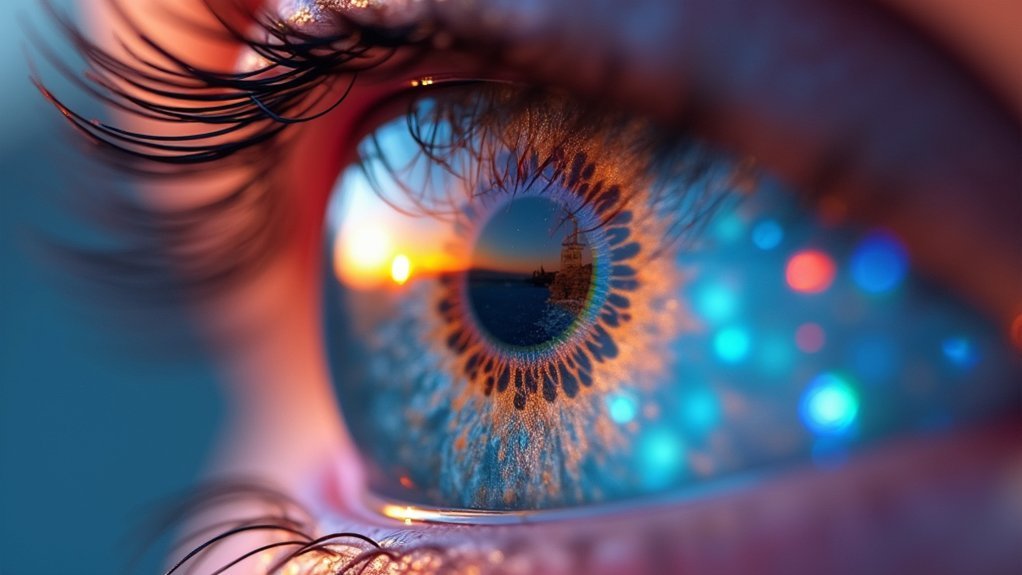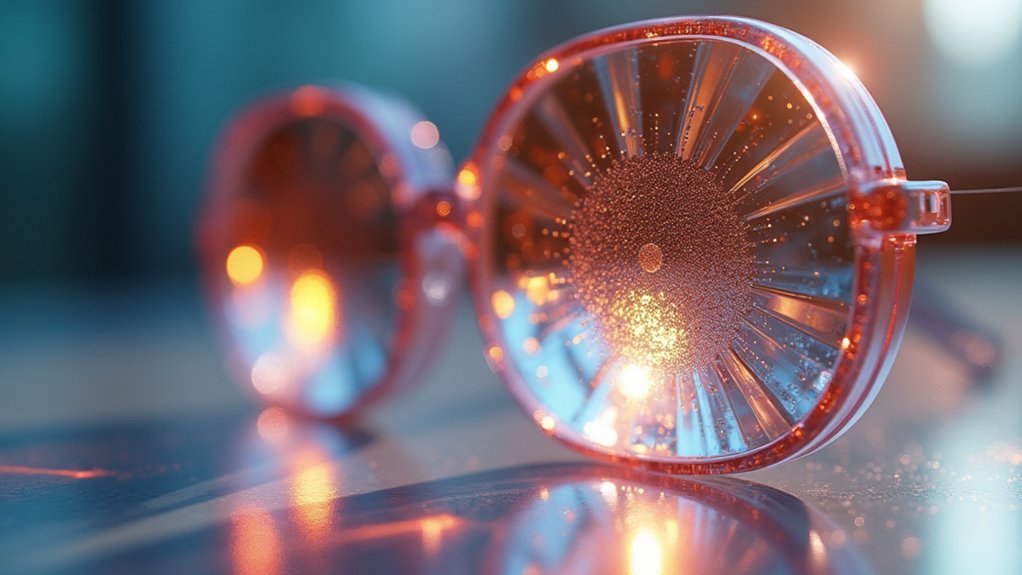VR lens quality enhances visual clarity through several key factors you’ll notice immediately. Advanced optical designs like hybrid fresnel aspheric lenses minimize distortion while maximizing sharpness across your entire field of view. Higher pixel density per degree (PPD) reduces screen-door effects, while specialized coatings eliminate glare and chromatic aberration. Quality materials like polycarbonate provide durability without compromising image fidelity. Custom prescription integration guarantees you won’t need glasses underneath your headset. The technical specifications below reveal how these elements work together.
Understanding Optical Precision in VR Lens Technology

When you put on a VR headset, you’re experiencing the culmination of sophisticated optical engineering that determines whether you’ll see crisp, immersive visuals or blurry, distorted images.
Optical precision forms the foundation of exceptional visual clarity in virtual reality systems.
Hybrid fresnel aspheric lenses represent cutting-edge technology that minimizes distortion while maximizing image sharpness.
These advanced lens designs combat chromatic aberration and reduce godrays that traditionally plague VR experiences.
High-quality materials like polycarbonate guarantee durability without compromising weight distribution.
Customization options, particularly adjustable interpupillary distance settings, align perfectly with your unique eye characteristics.
Modern innovations include blue light-blocking features that reduce eye strain during extended sessions.
This all-encompassing approach to optical precision transforms your VR experience from merely functional to truly immersive.
The Role of Pixel Density and Resolution in Visual Sharpness
You’ll find that pixel density and resolution work together to determine how sharp your VR visuals appear, but understanding the difference between PPD and PPI is essential for evaluating true visual quality.
The display technology in your headset—whether it’s micro OLED, traditional OLED, or LCD—directly impacts the maximum sharpness you can achieve.
You can optimize your VR experience by learning specific techniques that balance resolution demands with your hardware’s capabilities.
Understanding PPD Vs PPI
How do you determine whether a VR headset will deliver sharp, immersive visuals? Understanding the difference between PPD and PPI is essential for evaluating optical quality and visual clarity.
PPD measures pixels within your field of view, directly impacting visual fidelity in VR environments. PPI indicates display pixel density but doesn’t account for how you actually perceive images through VR lenses. Higher PPD values create more immersive experiences by reducing screen-door effects.
| Metric | Focus Area | VR Relevance |
|---|---|---|
| PPD | Field of view perception | High – directly affects clarity |
| PPI | Display density | Medium – hardware specification |
| Resolution | Total pixels | High – enables better PPD |
When evaluating headsets, prioritize PPD over PPI. A 3840×2160 resolution per eye with optimized PPD delivers superior visual clarity than higher PPI displays with poor optical implementation.
Display Technology Impact
Display technology fundamentals determine how effectively your VR headset converts digital content into sharp, lifelike visuals. The type of display technology directly impacts your visual clarity through pixel density and resolution capabilities.
OLED displays achieve superior pixel density around 800 PPI, delivering exceptional contrast and brightness that LCD screens can’t match. This enhanced pixel density translates to higher PPD values, meaning you’ll see more pixels within each degree of your field of view.
When your VR headsets utilize advanced display technology with resolutions like 3840×2160, you’ll notice dramatically improved detail visibility. Future developments targeting 14k x 6k per eye will create an even more immersive experience, pushing visual fidelity beyond human perception limits.
Resolution Optimization Techniques
Why does pixel density matter more than raw resolution numbers when evaluating VR visual sharpness?
You’ll find that pixels per degree (PPD) provides a more accurate measure of visual clarity than traditional pixel density measurements. While high-resolution displays boasting 3840×2160 or even future 14k x 6k per eye targets sound impressive, the immersive experience depends on how those pixels distribute across your field of view.
Advanced optical technologies like QD-OLED greatly enhance this equation by delivering superior color quality compared to standard OLED displays.
When you’re evaluating VR headsets, focus on PPD rather than raw resolution numbers. This approach guarantees you’ll achieve peak visual clarity, as it accounts for the actual pixel visibility within your viewing angle, creating a truly immersive experience.
How Lens Materials Impact Image Quality and Durability
When you’re investing in a VR headset, the lens materials directly determine both the visual clarity you’ll experience and how long your device will last.
Polycarbonate lenses offer exceptional durability while blocking 100% of harmful UV rays, maintaining optical clarity during extended gaming sessions. High-index lenses provide thinner profiles for stronger prescriptions, reducing weight without compromising visual quality.
Polycarbonate lenses deliver unmatched durability and complete UV protection while high-index options reduce weight for prescription users.
You’ll benefit from scratch-resistant coatings that protect against daily wear while preserving clear visuals over time.
Advanced lens materials incorporating blue light blocking technology reduce digital eye strain, allowing for comfortable extended use.
These material choices guarantee your VR headset withstands active gaming while delivering consistently sharp image quality and enhanced durability throughout its lifespan.
Chromatic Aberration Correction for Distortion-Free Viewing

Although your VR headset’s lenses may appear flawless at first glance, chromatic aberration can quietly degrade your visual experience by splitting white light into its component colors, creating annoying color fringes around objects in virtual environments.
Modern VR lenses combat this issue through sophisticated optical designs that deliver distortion-free viewing:
- Advanced aspheric lens shapes minimize wavelength dispersion across your entire field of view.
- Hybrid fresnel designs reduce color separation while maintaining compact headset profiles.
- Software-based enhanced correction works alongside hardware to eliminate remaining aberrations.
- Precision manufacturing guarantees consistent visual clarity from center to periphery.
These corrections greatly reduce eye strain during extended sessions.
You’ll notice sharper text, cleaner edges, and more vibrant colors that create a truly immersive experience.
Quality chromatic aberration correction transforms good VR into exceptional virtual reality.
Anti-Reflective Coatings and Their Effect on Visual Performance
Beyond correcting color distortion, your VR headset’s lenses require anti-reflective coatings to access their full visual potential.
These specialized coatings eliminate surface glare and reflections, allowing more light to pass through your VR lenses for enhanced visual clarity. You’ll experience improved contrast and color accuracy that makes virtual environments more immersive and detailed.
Anti-reflective coatings maximize light transmission through VR lenses, delivering sharper contrast and richer colors for truly immersive virtual experiences.
Anti-reflective coatings help you maintain focus on virtual scenes without distracting reflections, reducing eye strain during extended gaming sessions.
When combined with blue light-blocking technology, these coatings provide superior protection against digital eye strain. The result is comfortable, prolonged VR use with crystal-clear visuals.
Quality anti-reflective coatings also protect your lenses from scratches and wear, ensuring consistent visual performance throughout your headset’s lifespan.
Field of View Optimization Through Advanced Lens Design

Since modern VR headsets rely heavily on field of view to create convincing immersion, advanced lens designs like hybrid fresnel aspheric lenses have revolutionized how you experience virtual environments.
These sophisticated optical systems optimize your visual experience through precise engineering that minimizes distortion while maximizing clarity across the entire spectrum.
Here’s how advanced lens design enhances your VR experience:
- Custom optical alignment tailored to your interpupillary distance and face depth guarantees perfect visual positioning
- Pancake optics for micro OLED displays provide heavy magnification while maintaining exceptional clarity
- High-quality optical materials with specialized coatings reduce glare and reflections during extended sessions
- Wider field of view delivers more natural, expansive views without significant edge distortion
This thorough approach to lens engineering creates seamless immersion that feels remarkably natural.
Blue Light Filtering Technology for Reduced Eye Strain
When you’re immersed in VR for hours, your eyes face constant bombardment from high-energy blue light that can trigger significant strain and fatigue. Blue light filtering technology addresses this challenge by incorporating blue light blocking coatings that specifically target harmful wavelengths while preserving visual clarity.
| Benefit | Impact | Result |
|---|---|---|
| Reduced Eye Strain | Less fatigue during sessions | Longer comfortable experience |
| Enhanced Contrast | Clearer visual definition | Improved virtual reality immersion |
| Sleep Protection | Minimized circadian disruption | Better rest after gaming |
| Long-term Safety | Reduced retinal damage risk | Eye health preservation |
This technology doesn’t just filter harmful light—it enhances contrast and reduces glare, creating more vibrant visuals. By protecting against prolonged exposure effects, these advanced coatings guarantee you’ll enjoy extended virtual reality sessions without compromising your eye health or visual performance.
Custom Prescription Integration for Enhanced Clarity
If you wear prescription glasses, you’ll appreciate how custom prescription VR lenses eliminate the awkward juggling act between your eyewear and headset.
Custom prescription integration transforms your VR experience by delivering crystal-clear vision without compromising comfort.
These specialized VR lenses offer several key advantages:
- Tunable focus adjustments that match your exact prescription requirements for ideal visual clarity
- Enhanced comfort through elimination of pressure points caused by wearing glasses under headsets
- Blue light-blocking technology integration that reduces eye strain during extended gaming sessions
- Comfortable fit customization that accommodates different prescriptions for shared VR experiences
Your custom VR lenses correct refractive errors including myopia, hyperopia, and astigmatism directly within the headset.
This seamless integration guarantees you’ll experience sharp, clear vision while maintaining the immersive quality that makes virtual reality so compelling.
Fresnel vs. Pancake Optics: Comparing Clarity Technologies
Two distinct optical technologies shape your VR visual experience: Fresnel and pancake optics.
Fresnel optics offer lightweight, thin designs but introduce artifacts like godrays and chromatic aberration that compromise visual clarity. You’ll notice these distortions can detract from your immersive VR experience.
Pancake optics deliver superior performance through advanced lens design that minimizes distortion across your entire field of view. You’ll experience sharper images with better light transmission, resulting in improved brightness and color accuracy. This technology provides enhanced comfort during extended VR sessions.
Hybrid fresnel aspheric lenses represent a breakthrough solution, combining both technologies’ benefits while reducing traditional Fresnel drawbacks.
Clarity comparison tests consistently show pancake optics outperforming Fresnel systems, offering you reduced visual distortions and a more comfortable viewing experience for truly immersive virtual environments.
Testing Methods for Measuring VR Lens Visual Performance
Understanding which optical technology performs best requires rigorous testing methods that accurately measure VR lens visual performance.
You’ll need extensive evaluation techniques to assess clarity across different scenarios and user conditions.
Essential testing methods include:
- Visual acuity assessment – Using Snellen charts at standardized distances and sizes to measure lens performance objectively.
- Multi-depth clarity evaluation – Testing sharpness distribution across various focal depths throughout the field of view.
- Motion clarity tests – Measuring pixel response times with moving visuals to detect blurriness during rapid movements.
- Personalized lens adjustments – Accommodating individual differences in interpupillary distance and prescription requirements.
User adaptation periods greatly impact results, as you’ll often experience improved perceived clarity over extended use.
Individual perception variability makes personalized testing vital for accurate lens performance evaluation.
Frequently Asked Questions
How to Increase VR Clarity?
You’ll boost VR clarity by adjusting IPD settings, using high-quality lenses, cleaning surfaces regularly with microfiber cloths, taking frequent breaks, and properly fitting your headset’s straps and padding.
How Does a VR Lens Work?
VR lenses bend light from screens to create focused images for each eye. They’re positioned at specific distances matching your interpupillary distance, ensuring proper alignment and reducing eye strain while you’re experiencing virtual reality.
How to Make a VR Headset More Clear?
Adjust your headset’s IPD settings to match your eye distance, clean the lenses regularly with microfiber cloth, guarantee proper head strap positioning, and consider prescription lens inserts if you wear glasses.
Why Is VR so Blurry Without Glasses?
You can’t focus properly on VR displays without your corrective lenses because the headset’s optics aren’t designed for your specific vision needs, causing blurred images and eye strain.





Leave a Reply